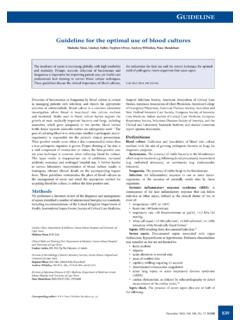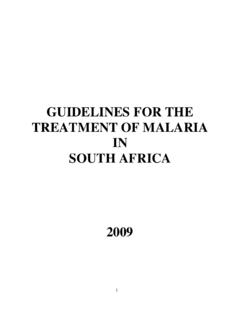Transcription of TABLE OF CONTENTS - Fidssa
1 1 TABLE OF CONTENTS PREFACE 2 ACKNOWLEDGEMENTS 3 1. EXECUTIVE SUMMARY 4 2. INTRODUCTION 5 DISTRIBUTION OF malaria 5 malaria THE DISEASE 5 malaria - THE MOSQUITO VECTOR 6 3.
2 PREVENTION OF malaria 7 Summary Box 1 7 AWARENESS AND ASSESSMENT OF malaria RISK 7 Factors determining malaria risk 8 MOSQUITO AVOIDANCE 8 Preventative measures for residents in malaria areas 8 Additional Preventive Measures For Residents and Visitors to malaria Areas 9 USE OF ANTIMALARIAL AGENTS FOR CHEMOPROPHYLAXIS 9 Summary Box 2 10 Indications for chemoprophylaxis 11 Choosing appropriate chemoprophylaxis
3 11 Summary Box 3 11 Measures to ensure effective and safe use of chemoprophylaxis 12 Efficacy and adverse reactions of recommended prophylactic regimens 12 Alternatives not recommended for prophylaxis 14 Patient-specific prescribing problems 14 Partial immunity (Semi-immunity)
4 20 Stand-by emergency treatment 20 ENSURING EARLY DIAGNOSIS 20 Signs and symptoms of malaria 21 22 INFORMATION SHEET 24 25 TABLE 1: DRUG CHOICE ACCORDING TO PATIENT FACTOR 25 TABLE 2: INTERACTIONS BETWEEN malaria CHEMOPROPHYLAXIS AND OTHER DRUG TREATMENT 26 TABLE 3: BENEFITS AND RISKS OF THE PROPHYLACTIC REGIMENS RECOMMENDED FOR TRAVELLERS 28 TABLE 4: DOSES OF ANTIMALARIAL DRUGS FOR USE AS PROPHYLAXIS 29 TABLE 5.
5 DOSES FOR STANDBY THERAPY 29 7. MAP OF malaria AREAS IN SOUTH AFRICA 30 MASKS THE SYMPTOMS - THE MYTH 31 9. LIST OF ANTIMALARIALS AND TRADE NAMES 31 OF malaria RISK AND PREVENTION INFORMATION 32 322 PREFACEM alaria is a potentially fatal disease that can be prevented in the majority of cases by taking appropriate precautions.
6 These guidelines , produced by the National Department of Health, provide detailed approaches to the options available for preventing malaria transmission in South objective of these guidelines is to provide health care practitioners with information on the most appropriate interventions for people who enter into malaria affected areas in South Africa. These guidelines incorporate the World Health Organization s guidelines for the prevention of guidelines include information on non-drug measures to prevent mosquito bites, determining whether chemoprophylaxis is indicated, selecting the most appropriate chemoprophylaxis to use, including the interactions between malaria chemoprophylaxis and other drug treatments and the benefits and risks of alternative chemoprophylactic agents.
7 A map of malaria risk in South Africa and detailed tables on antimalarial drug dosages have also been trust that these guidelines will be useful to all health care practitioners, and I thank all those involved in their B Hogan, MPMinister of Health_____MsBHogagggaggggagagaaaaaaaaaa an,nnnnnnnnnnnnnMPACKNOWLEDGEMENTSThe guidelines for the Prevention of malaria in South Africa were developed by the National Department of Health in close collaboration with several stakeholders and malaria would like to express my sincere gratitude to the Sub-Committee for Chemoprophylaxis and Therapy (SCAT) of the malaria Advisory Group who were responsible for drafting these guidelines . The SCAT members include: Mrs Lee Baker, Medicines information consultant, Amayeza Information Centre Dr Lucille Blumberg, National Institute for Communicable Diseases, National Health Laboratory Service Assoc Prof Karen Barnes, Division of Clinical Pharmacology, University of Cape Town Dr Frank Hansford, Department of Health (Chairperson)
8 Dr Cornelia Duvenage, Department of Internal Medicine, 1 Military Hospital Dr Gerhard Swart, CDC, Mpumalanga Department of Health Dr Etienne Immelman, KwaZulu Natal Department of Health Dr Jan van den Ende, Drs Martin & Sim/Toga Laboratories Pty Ltd Dr Bonnie Maloba, Dr Eunice Misiani, Ms Tsakani Furumele and Dr Devanand Moonasar, National Department of HealthSpecial thanks to the University of Cape Town Medicines Information Centre for allowing the use of information from their malaria Updates to be included in the compilation of these TD MselekuDirector-General Department of Health3_____MrTDDDMMsMMsMMMMsssMMMMMsMMM sMMMsssssMMMMMMMM ssssssMMMMMMMM ssssMMMMMMM ssselelelleeeeleleeeeeelleeeeeeleeeekeee euDiDiDiDiiiDDiiDDDDD iireeeeerereeeeeerrrreeeeeerrrreeerrrree rrrrctctccccctoor-GeneralDepa1.
9 EXECUTIVE SUMMARYM alaria poses a risk to travellers to, and residents in, malaria areas. Stringent non-drug measures should be taken to avoid mosquito bites throughout the year, even in areas of low malaria transmission intensity. In addition, effective chemoprophylaxis should be taken whenever and wherever the risks of acquiring malaria exceed the probability of experiencing a serious adverse reaction to the chemoprophylaxis. The risk of acquiring malaria is determined by the intensity of malaria transmission in the area and season of visit, as well as the length of stay, type of accommodation, and likely activities between dusk and dawn. The choice of chemoprophylaxis is determined by local antimalarial drug resistance patterns and patient factors including, co-morbid disease, drug interactions and activities.
10 Mefloquine or atovaquone - proguanil or doxycycline are currently the recommended prophylactic should be made aware that malaria should be urgently excluded with ANY febrile illness occurring within 1 week to 3 months after visiting a malaria area, regardless of whether or not chemoprophylaxis was taken or mosquitoes were seen. Early effective treatment is essential to prevent progression to potentially fatal severe material is intended for use by healthcare professionals. It has been compiled from information currently available, and although the greatest care has been taken, the Department of Health and its malaria Advisory Group do not accept responsibility for errors or omissions. The guidelines for prevention of malaria may change over time as parasite resistance patterns change.







